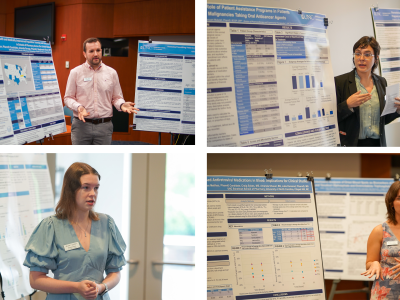April 2, 2012

Scientists at the UNC Eshelman School of Pharmacy and National Institute of Environmental Health Sciences have crystallized 3-O-sulfotransferase, giving a clearer look at the internal composition of an enzyme critical to making a synthetic form of the blood thinner heparin.
“It’s like having x-ray vision,” says Jian Liu, PhD, a professor at the School. “The crystal structure brings order to the approximately 300 amino acid residues that make up this enzyme that is a key to the biosynthesis of heparin.”
In the final stage of synthesizing synthetic heparin, 3-OST-1 combines with a cofactor to impart anticoagulant properties to a heparin substrate. The researchers identified several key amino acid residues that play important roles in substrate binding. Understanding the action and structure of 3-OST-1 allows further refinement of the synthesis of synthetic heparin, Liu says, by giving scientists the information to engineer versions of the enzyme to increase the accuracy of the process.
The research team’s findings were published online in the Proceedings of the National Academy of Sciences. The group includes Susan Woody, a first-year PharmD student at the School who is pursuing a PharmD-PhD track.
Heparin is most often used during and after such procedures as kidney dialysis, heart bypass surgery, stent implantation, indwelling catheters, and knee and hip replacement to prevent clots from forming. Heparin is extracted from animal tissue, chiefly from cows and pigs. Its side effects include uncontrolled bleeding and thrombocytopenia (too few platelets in the blood). The worldwide sales of heparin are estimated at $4 billion annually.
The natural form of the drug was in the spotlight in spring 2008 when more than eighty people died and hundreds of others suffered adverse reactions to it, leading to recalls of heparin in countries around the world. Authorities linked the problems to a contaminant in raw natural heparin extracted from pig intestines in China.
“A man-made version of heparin that can be made inexpensively under laboratory conditions is the key to preventing a recurrence of the 2008 tragedy,” Liu says.
Additional coauthors of the study are; Lars Pedersen, PhD, group leader of the Structure and Function Research Group of the National Institute of Environmental Health Sciences; and Robert Lindhardt, PhD, the Ann and John H. Broadbent Jr. ’59 Senior Constellation Professor at Rensselaer, along with Yongmei Xu, PhD, a postdoctoral research associate at the UNC Eshelman School of Pharmacy and Joseph Krahn and Andrea Moon of NIEHS.
The research described is supported by multiple grants from the National Institutes of Health.
Latest News

Dean Angela Kashuba receives Carolina Alumni Faculty Service Award

RASP poster presentations capture student research


